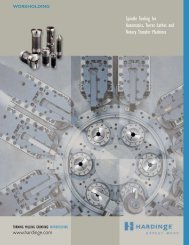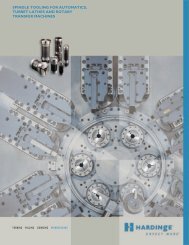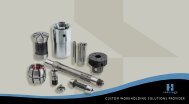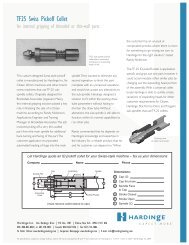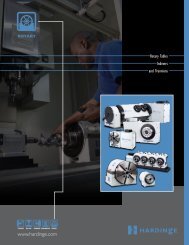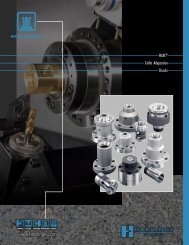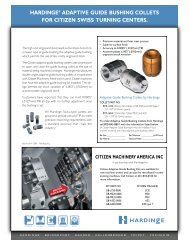Hardinge B160A DD100 Direct-Drive Rotary User Manual
Hardinge B160A DD100 Direct-Drive Rotary User Manual
Hardinge B160A DD100 Direct-Drive Rotary User Manual
You also want an ePaper? Increase the reach of your titles
YUMPU automatically turns print PDFs into web optimized ePapers that Google loves.
8<br />
<strong>DD100</strong> <strong>Direct</strong>-<strong>Drive</strong> <strong>Rotary</strong> Table Indexer <strong>User</strong> <strong>Manual</strong> B-160A<br />
of the <strong>DD100</strong> because when a part's mass gets further from the center of rotation, its inertia increases. An unbalanced<br />
part should also not require a torque that exceeds the allowable torque of the motor shown in section 1.7 of this<br />
document. A part weighing 5 lbs at a distance of 6 inches from the center of the spindle would require 30 in-lbs or 2.5<br />
ft-lbs of torque to rotate. See examples below for light parts that have high inertia.<br />
Note: Larger inertial loads may require changing a few motor parameters to get the unit to run properly. If assistance<br />
is needed in calculating inertia, torque, or changing parameters, please contact your local <strong>Hardinge</strong> representative.<br />
����������������������������������������������<br />
�<br />
���������������<br />
�������������������������<br />
����������������������������������������������������������<br />
����������������������������������������<br />
����������������������������������������������������������������������<br />
Inertia vs. Weight vs. Required Torque to Spin Part<br />
Example A Example B<br />
Material: Steel<br />
Weight: 5.3 lbs/2.4 kg<br />
Material: Steel<br />
Weight: 2.5 lbs/1.1 kg<br />
Inertia about axis of Rotation: 2.7 lb-in2 Inertia about axis of Rotation: 17.8 lb-in2 /0.0008 kg-m2 /0.008 kg-m2 �����������������������������������������<br />
Torque required to turn Unbalanced Part: N/A Torque required to turn Unbalanced Part:<br />
(Balanced) 7.5 in-lbs/0.85 Nm<br />
Example A is a balanced part which is approximately twice as heavy as Example B, which is an unbalanced part. Notice<br />
that since Example A is balanced, the torque required to hold the part in position is negligible and its moment of inertia<br />
is very low. Since Example B is unbalanced, its moment of inertia is about 10 times larger than Example A even though<br />
it weighs about half as much. Also, note that torque is required to hold Example B in position.<br />
1.4 Spindle Clamp Option<br />
�������������������������������������������������<br />
AXIS OF ROTATION<br />
������������������������������������������������������������<br />
�<br />
���������������<br />
������������������������<br />
�����������������������������������������������������������<br />
�������������������������������������������������������������������������������<br />
The <strong>Hardinge</strong> ® <strong>DD100</strong> <strong>Direct</strong>-<strong>Drive</strong> <strong>Rotary</strong> Table Indexer is available with an optional fail-safe spindle clamp. This clamp<br />
allows the spindle to handle cutting forces equal to 100 ft-lb/136 Nm, allowing for greater cutting forces in the non-<br />
contouring mode of operation. The unit contains a pressure sensor that will prevent indexing in the event that air<br />
pressure drops below 85 psi to the clamp so that damage is prevented. Air is supplied to the clamp through the cable<br />
conduit and is either connected to the back of the control box or the machine air supply in the machine canopy wireway.<br />
When equipped with the <strong>Hardinge</strong> servo control, the clamp can be controlled automatically so that the clamp is<br />
engaged when the <strong>Rotary</strong> Table Indexer arrives at its programmed destination or it can be controlled with "G" codes.<br />
For ease of use, a "C" will appear on the display of the control whenever the clamp is engaged. There is a potential for<br />
a drop in air pressure if the air line supplying the <strong>Rotary</strong> Table Indexer is also supplying something else with air. If you<br />
receive a low pressure alarm, the first thing you should check is the air pressure supplied to the <strong>Rotary</strong> Table Indexer.<br />
Please note that even a momentary drop in air pressure can create an alarm situation.<br />
<strong>Hardinge</strong> Inc. One <strong>Hardinge</strong> <strong>Drive</strong>, Elmira, New York U.S.A. 14902-1507 800.843.8801 (Canada 800.468.5946) www.shophardinge.com<br />
�2.0<br />
0.6<br />
AXIS OF ROTATION<br />
�1.0<br />
3.5<br />
Part No. BA -0009500-0160



